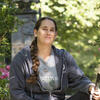Every day there are millions of people across the globe working to make the world cleaner, safer, healthier for today and tomorrow. For horticulturists to environmental scientists, marine biologists to law enforcement park rangers, there are countless careers focused on environmental research, the green industry, sustainability, education, advocacy and STEM — careers that are working diligently to create a better tomorrow around the globe! We invite you to learn about just a few of those careers.
Mariana Bonfim, a PhD candidate in Biology at Temple University and Research Assistant with the recently established Temple Ambler Field Station, has been thinking a lot lately about relationships. But not in the way you might think.
“Nature has a lot of different patterns, but why is an organism exactly the way it is? Why do sea anemones, for example, attach to hermit crabs? What is that relationship bringing to each of them?” asked Bonfim, who arrived at Temple and Field Station Director Dr. Amy Freestone’s Freestone Lab in 2015 having already amassed years of diverse research and teaching experience in Brazil. “For me, what I think is the most interesting thing about ecology as an aspect of biology is that it doesn’t just look at how things are but at why they are the way they are. That’s the beauty in ecology; it tries to understand the system and how everything is connected.” Read Mariana Bonfim’s story.
Mary Cortese: Taking a Deep Dive into Marine Science
Mary Cortese, a PhD candidate in Biology at Temple University and Research Assistant with the Temple Ambler Field Station and Freestone Lab, is not afraid to dive right into her interests. In fact, she prefers it. You’re as likely to find her below the water as above it, all in the service of leaving the planet a better place than she found it and educating others on the importance of doing the same.
“As a research assistant, I am very excited about being involved in a lot of community engagement and community outreach. I think back on to my childhood and the opportunities I had to be outside and explore,” said Cortese, who arrived at Temple University in August 2019. “Even if it wasn’t in a structured setup — even just walking through the woods with my Dad, or going to (the Great Smoky Mountains) National Park — there are so many benefits that come from that. With the Temple Ambler Field Station, I want to be able to say ‘Come outside and be outside with us.’ I think that’s a huge benefit to the community.” Read Mary Cortese’s story.
Diana Fernandez: Purposeful Planner

Temple Owls work to ensure all perspectives are represented. These fearless leaders, like Diana Fernandez, one of Temple’s 30 Under 30, are championing values of inclusivity, creating new pathways for marginalized groups and facilitating crucial conversations.
Diana Fernandez, TYL '12, knew from a young age that she wanted to change the world. Now, as a landscape architect in global design firm Sasaki Associates' Boston office, Fernandez literally shapes the soil and builds environments in locations across the country.
“It’s a culmination of my life experiences. Trying to work toward a more just future that is resilient for all people,” she said. “Land and landscape in the public realm is really the most poignant expression of power in our society. And if we can start to shape it differently, I think we can embrace and create new perspectives for how we can move through the world differently than we are today.” Read Diana Fernandez's story.
Julie Bare: Groundbreaking Gardener
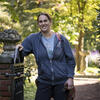
Cultivating strong neighborhoods takes humility, understanding and respect. Temple Owls like Julie Bare, another of one of Temple’s 30 Under 30, aren't afraid to get involved when they see a need. Our community advocates connect people to resources and opportunity, work to protect our environment and ensure all voices are heard.
When Julie Bare first came to Temple, she had never even heard the word "horticulture" before. Now, the senior estate gardener at the Pennsylvania Horticultural Society (PHS) Meadowbrook Farm has made it her calling.
"I can't believe how lucky I am that this is the world that I fell into. I had no idea that Philadelphia is America's garden capital," she said. “We focus on making beautiful gardens that educate the public about plants, gardening, pollinators and wildlife.” Read more of Julie Bare's story.
Sam Emory: Envisioning Ways to Heal the Soil
Since early 2020, an aging metal hulk has sat lifeless and dormant on a mile-long stretch of coastline where the Schuylkill transitions to the Delaware River in Southwest Philadelphia.
In 2019, an accident at the 1,300-acre Philadelphia Energy Solutions refinery — the largest refinery on the East Coast at the time — set off a series of explosions that released more than 5,000 pounds of hydrogen fluoride, a deadly gas, and sent pieces of shrapnel weighing more than 19 tons raining down on the site.
While the site has been purchased by a new developer with the likely intention of continuing industrial use, Sam Emory, a Master of Landscape Architecture (MLArch) student in the Tyler School of Art and Architecture, has an altogether different vision for the location — an ecologically sound answer to the question "What do you do with an old refinery about the size of Center City Philadelphia?" Read the full story.
Amy Freestone: Teaching Locally, Researching Globally
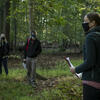
Antarctica. Madagascar. Panama. Alaska. Comoros. Belize. This isn’t a travelogue. They are just some of the places that Temple Ambler Field Station Director Dr. Amy Freestone’s research has taken her in her continued study of how species interact with each other and their environment.
“My research explores how local-scale ecological processes, such as species interactions, vary predictably across global gradients, particularly latitude. From the poles to the tropics, biodiversity, environmental conditions, and evolutionary history change substantially, and these changes can influence the way our natural communities operate,” said Dr. Freestone, an Associate Professor in Temple University’s Department of Biology in the College of Science and Technology where she leads research on the ecology and conservation of species diversity.
Dr. Freestone’s research and the work of the Freestone Lab bridges community ecology with macroecology, focusing on understanding feedbacks among processes that operate at the community scale and across regional to continental scales. She, several Temple PhD candidates and undergraduate researchers explore these processes and how they shape patterns of biodiversity. Their field studies and collaborative projects span pole-to-pole in the Americas, and to other continents as well. Read more of Dr. Freestone's story.
Rob Jennings: Researching the World's Water
How do we learn about the Earth’s water bodies? How do we discover new species living in our oceans or new threats to our clean water systems? Whether it’s on a beach, in a salt marsh, investigating a mud flat or far out to seas, one of the professions working on the front lines is marine biology.
Join Dr. Rob Jennings, Assistant Professor of Instruction in Biology and Laboratory Manager for Teaching Labs in the Biology Department at Temple University, as he shares insights into what it is like to be a marine biologist for 25 years. Visit here to head out to sea with Rob Jennings in Part II of Researching Water.
Laura Toran: Exploring Weather, Water and Land
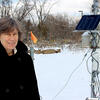
If you happen to ask Dr. Laura Toran “how’s the weather” she’ll be able to tell you in minute detail.
Her wireless weather station in the Ambler Arboretum of Temple University provides detailed, real-time reports on temperature, humidity, wind, sunlight, dew point and more.
“Temple Ambler is perfectly situated as a central point between several watersheds, making it a great location for the study of urban hydrology,” said Toran, Professor of Earth and Environmental Science in Temple’s College of Science and Technology. “The weather station on campus serves a number of purposes. I use it for monitoring conditions in the nearby watersheds such as Wissahickon Creek and it’s used to analyze precipitation patterns as part of ongoing stormwater management research.” Read the full story.
Cat Meholic: Recording History Through Plants
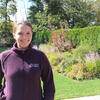
Cat Meholic believes that there was no one “Ah ha!” moment that instilled in her a passion for plants.
“I’ve wondered about that sometimes. I have three sisters and I’m definitely ‘the plant one,’” laughed Meholic, who joined the Ambler Arboretum of Temple University staff as the Curatorial Horticulturist. “I think initially it came from the people I encountered who took an interest in me. They had a great impact on my perspective on plants, on horticulture as an art and science — indoors and outdoors — and just how much technology is used in the field today. I always feel good at the end of the day when I’ve been working with plants.”
Meholic can look forward to many good days ahead as she splits her time between curation and routine garden management within the Ambler Arboretum. The Curatorial Horticulturist — a new position within the Arboretum — performs a critical function as the registrar of the plant collections, coordinating documentation from the point of acquisition through installation. Additionally, the position is responsible for evaluating accessions — additions to the collections — documenting their health and status in the garden and their effectiveness towards fulfilling the scope of the collections. Read the full story.
Benjamin Snyder: Managing a Population of Thousands
The 2,500 to 3,000 plants in the Greenhouse Education and Research Complex, a key component in the Temple Tyler School of Art and Architecture’s Landscape Architecture and Horticulture programs, are being diligently cared for at Temple Ambler.
“The fundamental goal is to keep the teaching and research collection alive and thriving for our students, faculty and researchers. Our collection includes many plants that were collected in the wild, as well as rare items that you’re not going to easily find and replace,” said Benjamin Snyder, Manager of the Greenhouse Education and Research Complex at Temple Ambler. “The Greenhouse, essentially, follows the same guidelines as an animal care facility. We have some wonderful species, such as Bird of Paradise, flowering cacti and lots of orchids, including the coconut pie orchid, which remarkably smells exactly like you think it would."
In this video, Snyder shares an insider’s view on the essentials of greenhouse management.
Abra Lee: Conquering the Soil and Highlighting Black Garden History
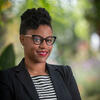
Abra Lee, owner of Conquer the Soil, has been digging in the dirt for as long as she can remember. Horticulture is integrally part of her family, her culture, her history. After years in the Green Industry as a municipal arborist, landscape manager, grounds superintendent, extension agent and Longwood Gardens Fellow working internationally in France, Lee has dedicated her life to uncovering and sharing stories that need to be told. She founded Conquer the Soil as a platform that combines Black garden history and pop culture to raise awareness of horticulture.
“I just changed my Instagram profile to the ‘Reigning Hype Woman of Black Garden History’ and that’s really what I do today. I am out here hyping people up on these under told stories. It’s not just Black garden history, this is American history, she said. “There are many days where I feel some anger because why didn’t I know this history before? Why wasn’t I taught this? Then you also say ‘This is so good. These people deserve their shine,’” she said. “I don’t care that they’ve been gone 50 years, sometimes 100 years. You can’t do anything but feel uplifted and educated and proud — extra proud for me as a Black woman who has literally worked in their shoes — as an American. I tell these stories; they are my passion, they are my platform and I am proud of them. I just want to continue to evolve that work and turn these things into curriculum, turn these things into programs.” Read Abra Lee's story.
Jon Nyquist: Understanding Earthquakes
What causes earthquakes? What is plate tectonics? What does magnitude measure? Join Dr. Jonathan Nyquist, Temple University Director of General Education and the Weeks Chair of Environmental Geology in the Department of Earth and Environmental Science in Temple’s College of Science and Technology, as he explores earthquakes and the study of earthquakes.
Earthquake forecasting is no simple task — there is long-term forecasting and short-term predication. Early warning is measured in seconds (which if you’re a computer controlling an electrical grid can make all the difference). To understand earthquakes on the East Coast (which do indeed happen) you also have to explore the past — the definition of an active fault is one that has moved in the past 10,000 years! The Mercalli Intensity Scale helps geophysicists of today study the earthquakes of yesterday based on written records.
Savannah Shepherd: Shining a Spotlight on a Dark History that Needs to be Shared
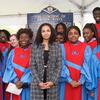
For young people, finding your "voice" is an essential part of the long journey into adulthood. For Savannah Shepherd, she found her voice while shining a bright spotlight on a dark part of the history of this country, the story of a man brutally lost to racial terror.
"It all started for me on a trip to Montgomery, Alabama, to visit The Legacy Museum and the National Memorial for Peace and Justice, which was opened by the Equal Justice Initiative (EJI)," said Shepherd. "My whole family went down there for the opening of those two incredible places. It was there that I actually learned about the only documented lynching in Delaware."
Learning the horrific truth about George White called Shepherd to action and she set about founding the Delaware Social Justice Remembrance Coalition. She was just 15-years-old at the time. Read the full story.
Abigail Long: Landscaping Her Future
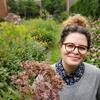
Landscape Architecture senior Abigail Long isn’t someone who's not willing to get her hands dirty. She’s not one to just wait around for something to come to her either.
“I want the hands-on experience. For me personally, I think that’s how I learn the best — diving in there and figuring out how to do it,” said Long, 30, who returned to the classroom in 2015 after working several years in the restaurant industry. “You can be told how to do something, but it’s not really until you’re in a situation where you need to grapple with it that you fully understand the concepts. That’s been one of the biggest benefits of coming to Temple, getting the chance at the Ambler Campus to try out so many different things in real-world situations.” Read Abigail Long's story.
Thao (Emma) Le: Meeting the Challenges of Horticulture Head-on
There is a metaphor to be found clear as day in one of Temple University Horticulture alumnus Thao (Emma) Le’s first introductions to Temple University.
“I remember taking the virtual tour on Temple’s website and there it was — the rock-climbing wall,” said Le, an international student from Hanoi, Vietnam. “I climbed it my first semester here. By my fourth semester I was hired to work at the rock-climbing wall and that community has had my back ever since.”
Challenge, meet Emma Le. You don’t stand a chance. Her stratospheric 3.99 grade point average, not one but three internships, and the dedication she exemplified to her major and the University community as a whole is testament to that. Originally planning to study psychology, a change in focus by the Vietnamese government set her on a different course, Le said.
“About three months prior to the semester starting, that summer after senior year I became aware of the fact that our government in Vietnam had a new set of representatives. Parliament was being more serious about investing in agriculture and sustainable growing and farming,” she said. “I thought ‘I like food, I like plants. I want to know where food comes from,’ so I switched from psychology to horticulture. I think it has a lot to do with working with something that involves my hands. Having something to physically care for in front of my eyes and seeing it grow is what made me want to stick with the major.” Read Thao (Emma) Le's story.
Darryl Sanford: The Value of the Journey
Darryl Sanford has been part of the Temple University community for most of his adult life, initially as a student in 1983. He completed his undergraduate degree in Mechanical Engineering and shortly after graduation took a “temporary” job with Temple’s Library system. Fast-forward to 2020 and that temporary position has been a full-fledged career dedicated to supporting Temple students, faculty and staff that has spanned more than 30 years. When he became part of the Temple Ambler campus community, Sanford said, “I was very pleased; I knew it was the right place for me.” Connecting with the community also re-ignited a spark, an educational dream that had remained unfulfilled.
“I’ve helped a lot of faculty over the years; helped them find resources for their classes, for their research, helped them find material for their students,” he said. “I’m always listening to the passion that they have and I said to myself, ‘Wait a minute. I go to a school that teaches horticulture. I want to study horticulture. What is wrong with me? I’m going to get my degree. I want to learn about horticulture!’ It took a while to realize I had this goal right here that I hadn’t grabbed a hold of, but then it was all so clear — let’s do this…and I did.” Read Darryl Sanford's story.
Elizabeth Krohn: A Life Dedicated to Impacting the Human Spirit
Elizabeth Krohn was never meant for an indoor profession. The Class of 2020 graduate, who is completing her Master of Landscape Architecture degree, was meant for the outdoors, positively impacting environments and uplifting underserved communities.
“I grew up in seven different states; I got to experience a lot of different environments. I remember even as a kid seeing those differences and wanting to learn as much as I could about them,” said Krohn, who came to Temple with bachelor’s degrees in both biology and environmental science in addition to a wealth of experience in public service. "I also have memories of hiking different areas with my dad and gardening with my mom and they were so supportive of my time outside and getting dirty or whatever I got into; I’m so grateful for that. Coming out of high school, I wasn’t exactly sure what I wanted to do, but I knew I was passionate about nature and environmental science.” Read Elizabeth Krohn's story.
Ibrahim Al-Nasser: Answering the Call for a Future in Horticulture
Temple University Horticulture alumnus Ibrahim Al-Nasser was formerly a biology major until the plants started “talking” to him, pointing him on the right path for his future.
“I have almost an inner voice — a guide that’s telling me where I need to go, where I need to be. So, when it told me to pursue my degree in the United States, I made it happen,” said Al Nasser, a Temple international student and member of the Class of 2020 originally from Sana’a, Yemen. “
For Al-Nasser, discovering horticulture was a return to a true passion, he said.
“As a kid I remember my grandfather having a few farms and a few small family orchards. I used to go there and work, but I didn’t appreciate what that experience meant to me until I grew up in cities and urban environments,” he said. “It is riveting to be outside, to have your hands in the dirt, your feet in the mud — I lost touch with nature growing up. When I came to Pennsylvania, I strove to get outside and see more natural places, go to more parks, get more involved with trees and see them as living beings; I wanted to care for them.” Read Ibrahim Al-Nasser's story.
Michelle Armour: Discovering the Art of Landscape Architecture
Michelle Armour knows a little something about creating art. She also knows about healing and restoration. For the Tyler School of Art and Architecture and Temple Ambler graduate, Landscape Architecture was the perfect marriage of both, richly combined with science, sustainable and environmental action, and working directly with communities to initiate change.
“I went to Temple for one semester after graduating high school but really didn’t know what I wanted to be when I grew up, so I took a break from college. Before I came back to Temple Ambler, I was a professional massage therapist for about 7 years,” said Armour, who graduated with her degree in Landscape Architecture in 2020. “I taught yoga and was a musician and singer with several groups.”
One of the primary things that makes Tyler’s Landscape Architecture program unique is “the intimate community that’s here,” Armour said.
“You get to know people — classmates, faculty, staff — really well. We also had the opportunity to work on projects with real-world clients,” she said. “There was a neighborhood planning project that our class did in Kensington. There was a public square/public plaza train station project that we worked on in Narberth. Our senior project was a design for a playground and recreation center in Olney, Philadelphia.” Read Michelle Armour's story.
Chantel White: Uncovering History Through Plants

Dr. Chantel White is a time traveler. Her Wayback Machine is currently set to 42,000 years in the past where a group of the first anatomically modern humans settled in a cave in what is now Jordan. Unlike many other archeologists, Dr. White doesn’t uncover the past through bones or carvings or structures. She finds history in plant material such as seeds and wood.
“In archaeology, there has been a lot of research about large scale agriculture — the beginning of farming, plant domestication, the development of staple crops that fed thousands,” said Dr. White, archaeobotanist at the University of Pennsylvania Museum of Archaeology & Anthropology. “There isn’t nearly as much research into how plants were part of people’s daily lives, orchards and vegetable gardens for example, and very little research into ornamental gardens. I wanted to explore everyday interactions with plants and gain a better understanding of the human experience.” Read the full story.
Karyl Evans: Preserving the Legacy of Beatrix Farrand
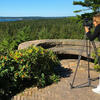
When Karyl Evans came to the Ambler Arboretum of Temple University in the fall of 2017, it was a bit like seeing a dream.
After studying the life and work of Beatrix Farrand for years, she was actually standing in the wonderfully preserved Louise Bush-Brown Formal Perennial Garden, which Farrand and James Bush-Brown designed in 1928.
“When I first saw the garden, I had an emotional response, it was so exciting. After being a trailblazer for women working in the field of landscape architecture, how pleased Farrand must has been to receive the commission to design this garden,” said Evans, a six-time Emmy Award-winning filmmaker. “Beatrix Farrand was the most successful female landscape architect in early 20th Century America and one of the founders of the American Society of Landscape Architects, a true pioneer in a male-dominated field. To create this signature garden for the Pennsylvania School of Horticulture for Women — itself known for opening so many doors for women in landscape architecture and horticulture — it must have held such significance for her.” Read the full story.
Landing the Perfect Landscape Architecture Job: Getting Hands-on with Technology
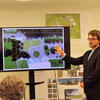
The building is pristine and new, all gleaming metal, unblemished brick and shimmering glass. The surrounding pathways are teaming with vibrant plant and animal life. Birds scatter at a passerby. The sun dapples the landscape with a mix of light and shadow through gently swaying trees.
Instructors are sharing their knowledge while students are engaged in hands-on learning experiences that will benefit them greatly after they leave Temple. It is a vibrant vision of the future at the Ambler Campus, a vision made possible by the exceptional creativity of landscape architecture students given the tools to take the ideas in their heads and give them photo realistic three dimensionality. Read the full story.
#WeAreFEMA: Environmental and Historic Preservation has a deeper meaning for Stephanie Everfield
Stephanie Everfield is a Regional Environmental Officer at the Federal Emergency Management Agency who helps to protect the integrity of the environment and historic landmarks in order to help strengthen and rebuild communities. This video is part of FEMA's #WeAreFEMA series, designed to provide insight on the staff behind FEMA's mission.
#WeAreFEMA: U.S. Deputy Fire Administrator Tonya Hoover
Tonya Hoover supports the training, education, and professional development of fire departments so they are better prepared to respond to all hazards. Learn more about the staff behind our mission. This video is part of FEMA's #WeAreFEMA series, designed to provide insight on the staff behind FEMA's mission.
Academy Unscripted: Jennifer Sonchi and Mark Sabaj
Academy Unscripted is a video series from the Academy of Natural Sciences featuring one-on-one conversations with Academy scientists. The first episode features Senior Director of Exhibits & Public Spaces Jennifer Sontchi talking with Interim Curator of Fishes Mark Sabaj. You can find more Academy Unscripted videos here.
Academy Unbscripted: Kathryn Christopher and Jordan Teisher
The second episode Academy Unscripted video from the Academy of Natural Sciences features Kathryn Christopher, Manager of Science Communication and Outreach, talking with Botany Collection Manager Jordan Teisher. You can find more Academy Unscripted videos here.
DRBC: Managing, Protecting & Improving the Water Resources of the Delaware River Basin for All
In this video, Delaware River Basin Commission Executive Director Steve Tambini discusses why the DRBC was formed and how it manages, protects and improves the basin's water resources without regard to political boundaries. The Delaware River is an interstate river its entire length, and all states with land draining to the river work together, through the DRBC, for the common goal of clean, plentiful water for all who depend on it.
What Does Public Works Do?
In this video from Upper Dublin Township, learn how Public Works departments support their communiuties. You'll also learn about the equipment used to do the varied jobs involved.
A Global Approach to Sustainable Urban Development
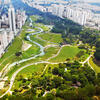
ICLEI – Local Governments for Sustainability is a global network of more than 2,500 local and regional governments committed to sustainable urban development. Active in more than 125 countries, including the United States, ICLEI influences sustainability policy and drives local action for low emission, nature-based, equitable, resilient and circular development. ICLEI makes sustainability an integral part of urban development and creates systemic change in urban areas through practical, integrated solutions. They help cities, towns and regions anticipate and respond to complex challenges, from rapid urbanization and climate change to ecosystem degradation and inequity.

